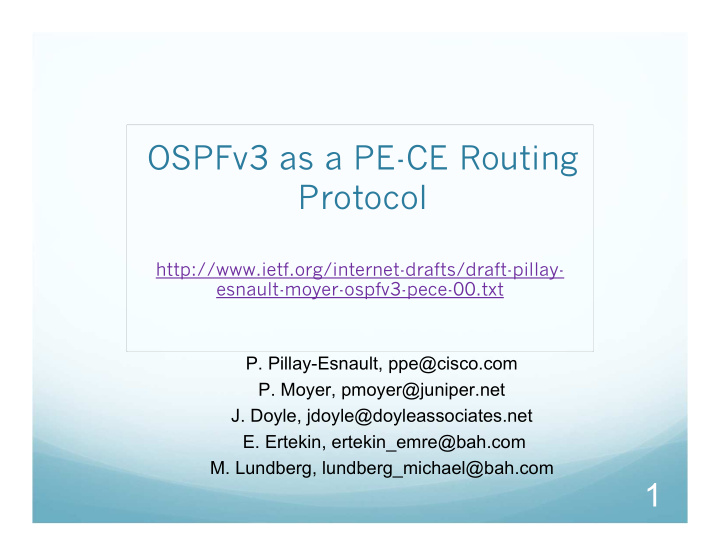



OSPFv3 as a PE-CE Routing Protocol http://www.ietf.org/internet-drafts/draft-pillay- esnault-moyer-ospfv3-pece-00.txt P. Pillay-Esnault, ppe@cisco.com P. Moyer, pmoyer@juniper.net J. Doyle, jdoyle@doyleassociates.net E. Ertekin, ertekin_emre@bah.com M. Lundberg, lundberg_michael@bah.com 1
Agenda OSPFv2 as a PE-CE Protocol Differences between RFC 4577 and this I-D New BGP Extended Community Support for Multiple OSPFv3 Instances per VRF Next Steps 2
OSPFv2 as a PE-CE Protocol Specification detailed in RFC 4577 and RFC 4576 Motivations include Offloading BGP requirements (support, management) from customer sites Path preference (backdoor path vs. VPN path) for multi-homed customer networks Provide the MPLS-VPN service to customers without having to radically change their IGP network with the MPLS-VPN Backbone acting as a super-backbone Keep the basic premises of OSPF the same : Type-1 and Type-3 LSAs for internal information Type-5 and Type-7 LSAs for external information Routing services offered Inter-area routing connectivity between VPN sites BGP Extended Community Attributes carry OSPFv2 specific information Type 3/5/7 LSAs can be originated based on the contents of the extended communities Intra-area routing connectivity between VPN sites (sham links) A sham link creates a pt-pt intra-area link between VRFs LSAs are flooded across the sham link OSPFv3 as a PE-CE protocol has similar requirements as specified in RFC 4577. It has consistent behavior and format with OSPFv2 3 where applicable
Differences between RFC 4577 and this Draft New BGP extended community encodings for OSPFv3 Route Types Intra-area-prefix LSA (0x2009) carries the prefixes which were previously carried by Type 1 and Type 2 LSAs in OSPFv2 Multiple OSPFv3 protocol instances can be established over a single link. (rfc5340 section 2.4) All instances defined on a link consequently belong to the same vrf. Assignment of Domain IDs on a per-VRF or a per-OSPFv3 instance basis <Domain ID, Instance ID> tuple is used for demultiplexing Multiple OSPFv3 instances can be established across the sham link to support multiple intra-area connections across the same sham link Instance ID within the OSPFv3 header is used to distinguish between multiple OSPFv3 instances 4
BGP OSPFv3 Route Extended Community Allocated from the IPv6 Address Specific BGP Extended Communities Attribute draft-rekhter-v6-ext-communities-02 Extended community allocation contains same fields as OSPFv2; however all fields are now packed into a single attribute DomainID, RouterID, AreaID, and Options field formats remain identical to RFC 4577 Route Type field contains new LSA encodings Addition of an OSPF Instance ID field 5
Next Steps Find a home/working group that is interested in the document Most likely L3VPN (home of rfc4577) in Minneapolis Multiple address families support using instance-id Comments welcome! 6
OSPFv3 Address Families – Instance ID The OSPFv3 Instance ID values have been assigned as follows in draft-ietf- ospf-af-alt-06.txt Instance ID # 0 - # 31 IPv6 unicast AF Instance ID # 32 - # 63 IPv6 multicast AF Instance ID # 64 - # 95 IPv4 unicast AF Instance ID # 96 - # 127 IPv4 multicast AF Instance ID # 128 - # 255 Unassigned The Instance ID is used to de-multiplex the address family if multiple address families are supported The BGP v6 route attribute carries all the needed info for support of ipv4 AF. 7
Support for Multiple OSPFv3 Instances Per VRF Instance ID for Inter-area links between PEs Instance(s) on PE-CE link are mapped to an Instance ID associated with the PE-PE link Instance ID of the PE-PE link is encoded in the OSPFv3 Route Extended Community <Domain ID, Instance ID, Route Type> is used to determine the Lsa Type for imported prefixes. Instance ID for Intra-area links between PEs Sham link is established between two VRFs similar to rfc 4577 Multiple OSPFv3 instances may be established across this sham link Each intra-area link is associated with an Instance ID within the OSPFv3 header as specified in RFC 5340 8
Recommend
More recommend